Hey everyone!
Time for a review.
As a preface, for my work, I like the long hand approach. I like the thought process that goes into forming the word choices and sentence structure that comes along with using your hand to write and not your fingers to type. This may come from my logical brain overwhelming the situation as I have been a software developer for almost 2 decades. When I type, my brain goes on autopilot until I get a ping that says I need to think again. When I write long hand, I am present for the whole thing.
That said, I don’t like dealing with ink and paper. Very simple, I don’t like the possibility of losing my work and have found solutions since 2015 to not have to hand write with ink and paper. With digital files, you can write simple scripts to automatically back up all your data and save it into multiple places. Once put into a word processor, you can search and edit or add segments easily.
I also prefer to edit in both long hand and typing formats. These approaches differ depending on how I started my project and how I plan to see it through.
Boogie Board Sync

I started my longhand digital writing journey with a meager budget and a specific need. To write long hand, in a form that I could digitize easily. I found the Boogie Board Sync. It would take one page at a time of hand written data and sync it with my phone page by page into .pdf files. This was a great little device and cheap too, $79.99 for the device itself. I wrote the first 50 pages of a novel a plan to revisit when the time is right on this thing. The digitizer would sometimes cause issues where there were errant lines coming off of strokes, but this was a great start. There was no way to load documents onto the device, it simply kept track of was was written on it and copied it to a .pdf file when you pressed the sync button. Primitive, but effective.
The colorful nature and light blue screen drawings were attractive for a certain audience, but for someone looking to use the tool for business as well as creative ventures, eventually I outgrew this device.
They still make them, albeit in a different size and format, but it looks like it still works the same.
I got to a point where I could afford a new device while my work required a more manageable workflow, thus I gave my trusty Boogie Board Sync to a co-worker and upgraded to the Sony DPT-S1.
Sony DPT-S1

This was a MAJOR upgrade in terms of what the device was capable of and what I could do with it.
It allowed you to save new documents and write on an E-Ink screen, directly to .pdf files. Swiping on the document at the end, would produce a new page and swiping back would allow you to navigate your previous work.
You could sync it up to a WebDAV server (which was popular back then, now you would be hard pressed to find a WebDAV server service. I had to host my own virtual machine to get a backup/networked solution in place) and always be up to date in 2 places.
I used this for years, albeit in limited fashion for my creative endeavors. I was heavy into work for the majority of the time I used this device, so it became a knowledge-base for all the projects I was working on at the time.
The device only dealt with .pdf files. You could load as many .pdf files as you could store on the internal memory and there was even a microSD card slot available for expanded storage.
The pen came with nibs that you would have to replace every so often as they would wear away as you wrote on the device.
Had I been able to focus on writing creatively during the time when I was using this device daily, I would have produced a significant amount of slush to go through, don’t get me wrong, I still have a couple dozen documents I created with this baby that I have to sort through.
Now, this device has been relegated to reference and research material. I sync documents from my main desktop to my WebDAV server and then download them over wifi to the device. It is mostly used supplementary to my Supernote Manta (See below), where having multiple screens is beneficial.
Supernote A5X

When I decided to write a novel, actually sitting down and wanting to write it, I was an impasse. I wanted longhand, but didn’t know what device would be the best for my use case. There were several that I had available to me. But there were 2 things that stood out to me and made me choose the Supernote A5X. “For Those Who Write” was their slogan at the time. Yes, it was that simple, that was what made me take notice. The second, was that you had a choice of a ceramic nibbed “Never Replace” pen. I was sold
This device was slightly smaller than the DPT-S1, but its well thought out UI (User Interface) along with syncing to Google Drive were exactly what I needed.
The A5X and its variants do not work directly on .pdf files like the DPT-S1 did. Instead, your notes are stored in a .note file and when you make notes on a .pdf file they are stored in a .mark file. You then export your Note or marked up PDF file to a .pdf file with all your doodles and notes.
There are tons of features, for instance, you can create a note with a format you will need often, export it as a PDF or PNG and use it as a template for pages in other documents. You can insert hyperlinks to other notes/documents/pages in notes and with the tap of your finger or the tip of your pen, be brought to your destination. Nothing i have used, besides the Manta comes close to how powerful an organizational system can be in longhand/digital form as this.
This device will take your notes and use OCR (Optical Character Recognition) to output a .txt file from which you can then import into a word processor and get to editing. What more could you ask for? This process is actually really good. My writing is handwriting is shit, and it got a good 80-85% without an issue.
Supernote A5X-2 (Manta)

Bigger, higher resolution and built with modular structure in mind, this device takes everything the A5X has and makes it faster.
They added a slide-bar on the left side that controls undo and redo actions as well as 2 finger gestures.
I write on this every day, it is my go-to tool for creating and I cannot say enough good things about it.
Wrap Up
That covers the long hand devices I have used over the last 10 years to make my writing accessible in the ways that I need it to be. I will follow up with a post about other tools in different categories that have been useful in my writing and technical life.
All endorsements of products, solutions, and services are on my own volition and are not due to paid advertisement or gifted products.